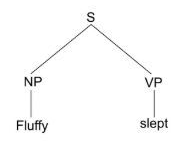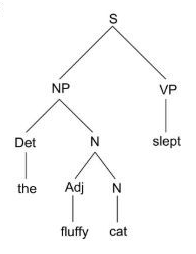Note
0.0(0)
Explore Top Notes Note
Note Studied by 50 people
Studied by 50 people Note
Note Studied by 20 people
Studied by 20 people Note
Note Studied by 7 people
Studied by 7 people Note
Note Studied by 30 people
Studied by 30 people Note
Note Studied by 19 people
Studied by 19 people Note
Note Studied by 1210 people
Studied by 1210 people
AP Psych- Unit 3 notes and flash cards
5.0(1)
Glossary of dental terminology
5.0(1)
Balancing
5.0(1)
apush 1.1-1.2 (pre-european contact)
5.0(1)
Law notes - unit 1
5.0(1)
Integration Methods to Know for AP Calculus AB/BC
5.0(3)
Chapter 5: Syntax
- Syntax- the component of grammar that deals with how words and phrases are combined into larger phrases
Basic Ideas of Syntax
- Linguistic expression- a piece of language with certain form, meaning, and syntactic properties
- Syntax is broadly related to how expressions combine with one another to form larger expressions
- Grammatical- when a string of words form a meaningful sentence
- Ungrammatical- when a string of words do not form a sentence
- Grammaticality judgement- a reflection of speakers’ mental grammar
- Not necessarily concerned with prescriptive rules
- Principle of compositionality- the meaning of a sentence depends on the meanings of the expressions it contains and on the way they are syntactically combined
- Difference between syntax and semantics:
- Sentences can @@contain strange meaning@@, and non-sentences can @@convey ordinary meaning@@
- Syntactic properties of expressions @@cannot be predicted or explained@@ on the basis of an expression’s meaning
Syntactic Properties
- Syntactic properties- the restrictions on certain combinations of expressions
- Word order- how expressions are allowed to be ordered with respect to one another
- Co-occurrence- if some expression occurs in a sentence, what other expressions can or must co-occur with it in that sentence?
- Argument- when the occurrence of one expression necessitates the occurrence of another expression
- Complements- non-subject arguments
- Well-formed sentences need to have all and only the arguments they need
- Adjuncts- optional expressions that can be added without creating a non-sentence
- Agreement- distinct expressions that agree with respect to some grammatical feature with the same value
Syntactic Constituency
- Syntactic constituent- syntactic units that can make up larger phrases in certain groups of expressions
- You can tell if a string of words forms a syntactic constituent if the words can answer a question
- Ex) Where is the cat sleeping? On the desk
- “On the desk” is a constituent
- Cleft- a sentence in which some constituent is displaced to the left
- If the cleft is grammatical, the displaced expression is a constituent
- Ex) The cat was sleeping on the desk → It was the cat that was sleeping on the desk
- “The cat” is a constituent
- Substitution- replacing a string of words with a single word.
- If substitution results in a grammatical sentence, the string of words is a constituent
- Ex) The cat was sleeping on the desk → She was sleeping on the desk
- “The cat” is a constituent
Syntactic Categories
- Syntactic category- a set of expressions that have approximately the same word order and co-occurrence requirements
- Syntactic distribution- if two expressions are interchangeable in all syntactic environments
- Ex) Sally likes the cat → Sally likes Fluffy
- The cat and Fluffy have the same distribution
| Syntactic Category | Relevant Properties | Example |
|---|---|---|
| S (sentence) | can occur in Sally thinks that _ | Fluffy is cute |
| NP (noun phrase) | has the same distribution as a personal pronoun or a proper name | she, Sally, the cat, this cute dog, that cat under the bed |
| N (noun) | needs a determiner to its left to form a NP | cat, cute dog, cat under the bed |
| Det (determiner) | occurs to the left of the noun to form a NP | the, every, this |
| Adj (adjective) | occurs in between a determiner and a noun; can be a noun adjunct, that is, combines with a noun to its right which results in an expression that is also of category N | cute, fluffy, gray |
| VP (verb phrase) | consists minimally of a verb and all its complements; combines with an NP to its left which results in a sentence; has the same distribution as slept or did so | slept, write the letter quickly, liked Bob, walked, believed she liked that man |
| TV (transitive verb) | needs an NP complement to form a VP | liked, devoured |
| DTV (ditransitive verb) | needs two NP complement to form a VP | gave, sent |
| SV (sentential complement verb) | needs a sentential complement to form a VP | believed, said |
| Adv (adverb) | can be a VP adjunct, that is, combines with a VP to its left which results in an expression that is also of category VP | fast, quickly, tomorrow |
| P (preposition) | combines with an NP to form a PP | at, for, with |
| PP (prepositional phrase) | can be a VP or an N adjunct; consists of a preposition and its NP complement | at the table, for Sally, under the bed |
Constructing a Grammar
Phrase structure rules- captures patterns of syntactic combination
- Ex) In English, S → NP VP
Phrase structure tree- a visual display of the way a sentence is built up from lexical expressions using the phrase structure rules


Ambiguous- linguistic forms can correspond to more than one expression
- Ex) They went for a walk vs They walk quickly
- Can be individual words or entire structures
Note
0.0(0)
Explore Top Notes Note
Note Studied by 50 people
Studied by 50 people Note
Note Studied by 20 people
Studied by 20 people Note
Note Studied by 7 people
Studied by 7 people Note
Note Studied by 30 people
Studied by 30 people Note
Note Studied by 19 people
Studied by 19 people Note
Note Studied by 1210 people
Studied by 1210 people
AP Psych- Unit 3 notes and flash cards
5.0(1)
Glossary of dental terminology
5.0(1)
Balancing
5.0(1)
apush 1.1-1.2 (pre-european contact)
5.0(1)
Law notes - unit 1
5.0(1)
Integration Methods to Know for AP Calculus AB/BC
5.0(3)